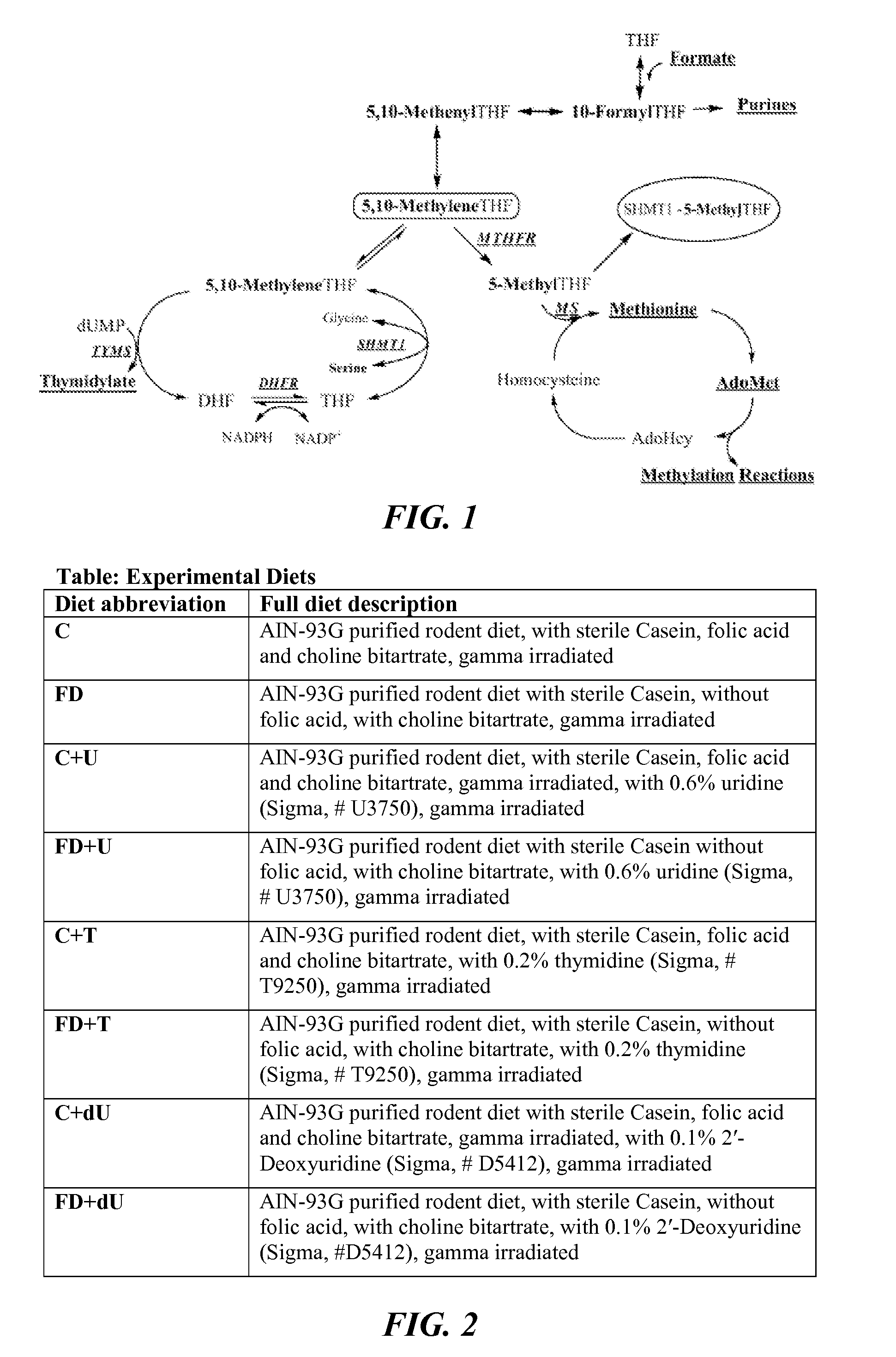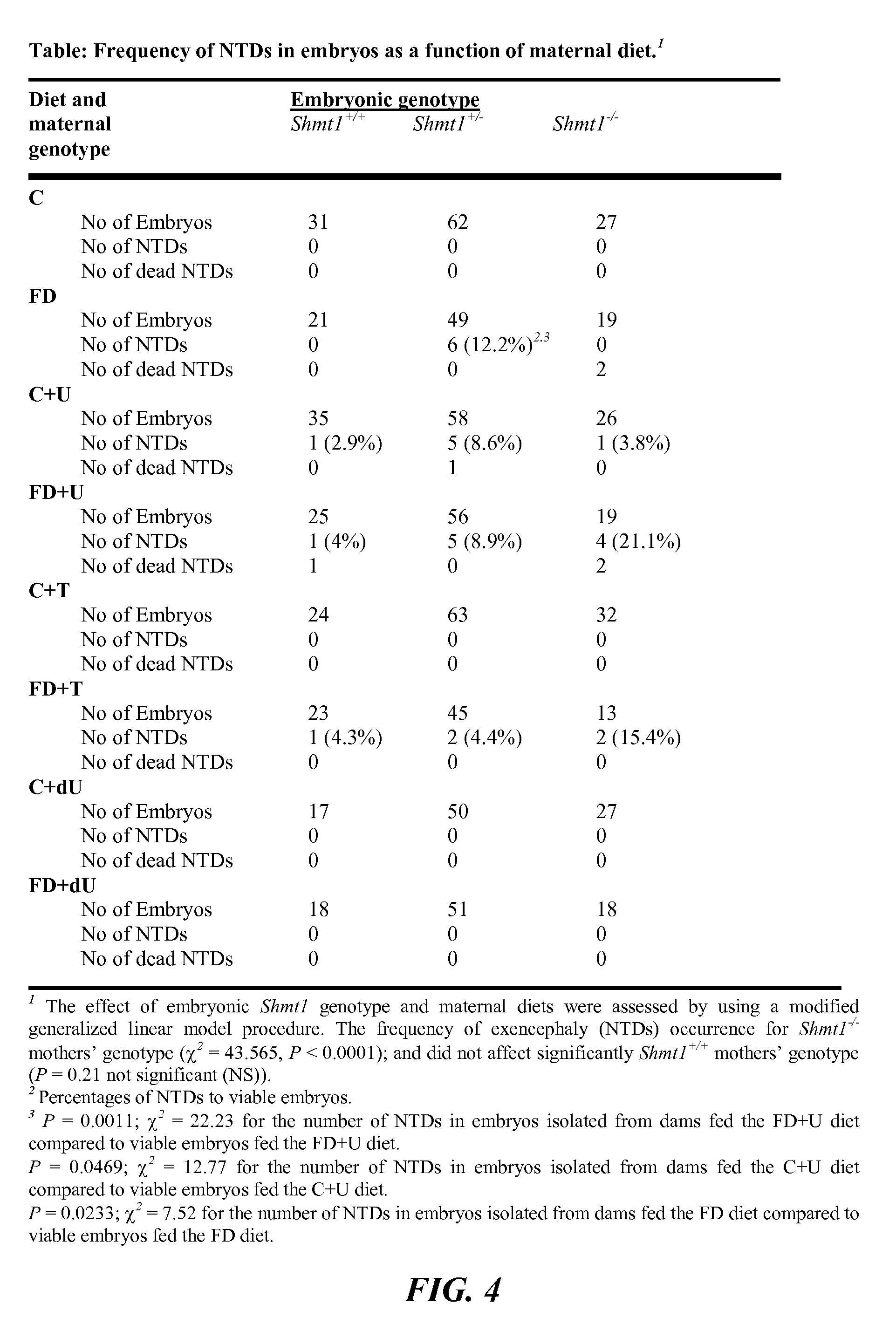Use of uridine and deoxyuridine to treat folate-responsive pathologies
a technology which is applied in the field of use of uridine and deoxyuridine to treat folate-responsive pathologies, can solve the problems of insufficient biomarkers for predicting disease risk, insufficient molecular mechanisms, and increased risk of birth defects, so as to prevent birth defects, enhance birth defect rates in shmt1+/, and prevent birth defects
- Summary
- Abstract
- Description
- Claims
- Application Information
AI Technical Summary
Benefits of technology
Problems solved by technology
Method used
Image
Examples
example 1
Mouse Model
[0110]NTDs were examined in litters harvested from crosses of 129SvEv-Shmt1 (N=10 and more) mice. Shmt1+ / −, Shm1+ / +, and Shmt1− / − mice were generated from Shmt1+ / − breeding pairs maintained as a heterozygote breeding colonies. Shmt1+ / + and Shmt1− / − female mice were then crossed to Shmt1+ / − male mice for timed mating experiments, as described below.
example 2
Experimental Animals and Diets
[0111]Mice were maintained on a 12-hour light / dark cycle in a temperature-controlled room. For studies investigating Shmt1 disruption and NTDs, female mice were randomly assigned at weaning to experimental AIN93G diets containing folic acid (C) or AIN93G lacking folic acid (FD) (FIG. 2) and including 0.6% uridine (Rudolph F B & Van Buren C T (1993), which is hereby incorporated by reference in its entirety), 0.2% thymidine (Iwasa et al., “The Well-Balanced Nucleoside-Nucleotide Mixture ‘0G-VI’ for Special Medical Purposes,”Nutrition 13(4):361-364 (1997), which is hereby incorporated by reference in its entirety), or 0.1% 2′-Deoxyuridine supplementation (Dyets, Bethlehem, Pa.). Diets were assigned with these abbreviations: AIN-93G as control (“C”); Folate Deficient (“FD”), C+ supplemented with 0.6% uridine (“C+U”), C+ supplemented with 0.2% thymidine (“C+T”), C+ supplemented with 0.1% 2′-Deoxyuridine (“C+dU”), FD+ supplemented with 0.6% uridine (“FD+U”),...
example 3
Genotype Analysis
[0113]Genotyping for the sex was performed using established protocols (Clapcote et al., “Simplex PCR Assay for Sex Determination in Mice,”Biotechniques 38(5):702, 704, 706 (2005); Machado et al., “Diabetic Embryopathy in C57BL / 6J. Mice. Altered Fetal Sex Ratio and Impact of the Splotch Allele,”Diabetes 50(5):1193-1199 (2001); McClive et al., “Rapid DNA Extraction and PCR-Sexing of Mouse Embryos,”Mol. Reprod. Dev. 60(2):225-226 (2001), which are hereby incorporated by reference in their entirety). Genotyping for Shmt1+ / +Shmt1− / − and Shmt1+ / − alleles was performed using a previously described protocol (MacFarlane et al., “Cytoplasmic Serine Hydroxymethyltransferase Regulates the Metabolic Partitioning of Methylenetetrahydrofolate but is Not Essential in Mice,”J. Biol. Chem. 283(38):25846-25853 (2008), which is hereby incorporated by reference in its entirety).
PUM
 Login to View More
Login to View More Abstract
Description
Claims
Application Information
 Login to View More
Login to View More - R&D
- Intellectual Property
- Life Sciences
- Materials
- Tech Scout
- Unparalleled Data Quality
- Higher Quality Content
- 60% Fewer Hallucinations
Browse by: Latest US Patents, China's latest patents, Technical Efficacy Thesaurus, Application Domain, Technology Topic, Popular Technical Reports.
© 2025 PatSnap. All rights reserved.Legal|Privacy policy|Modern Slavery Act Transparency Statement|Sitemap|About US| Contact US: help@patsnap.com



